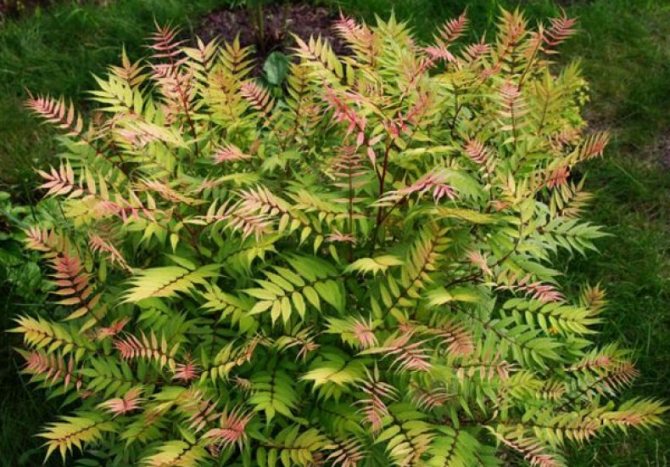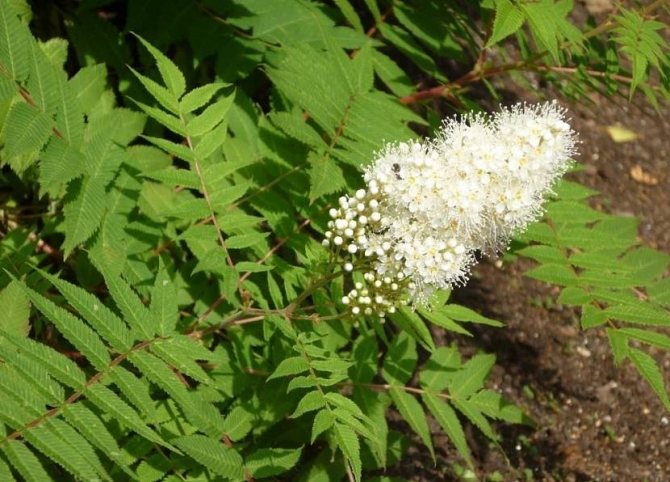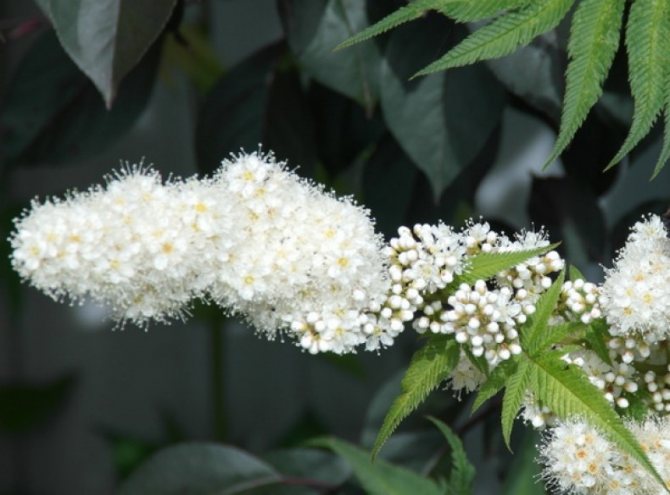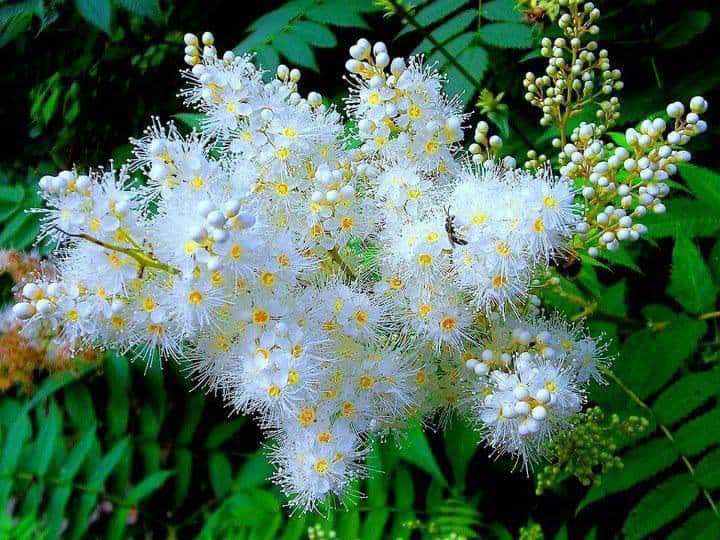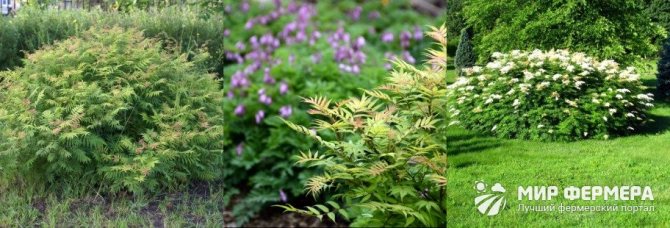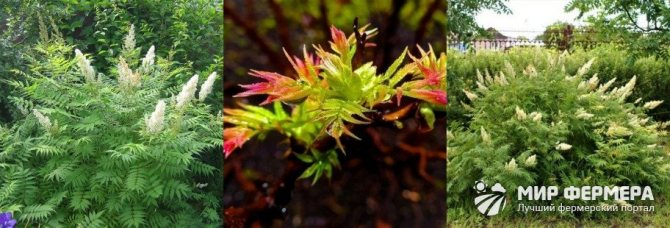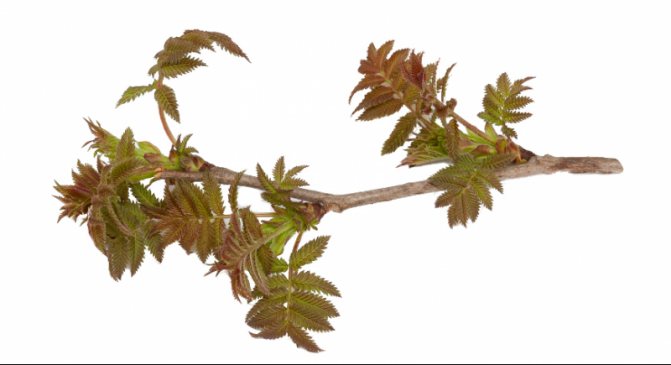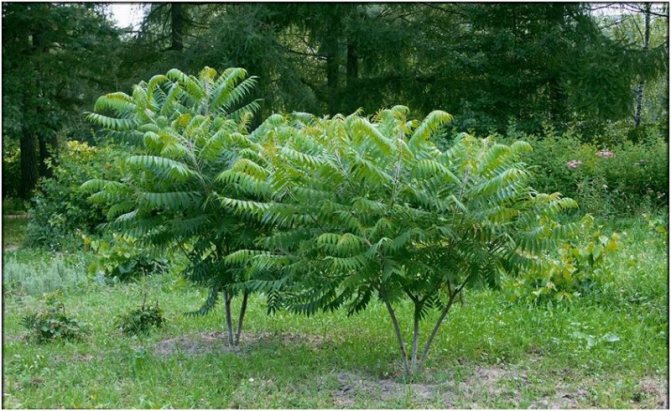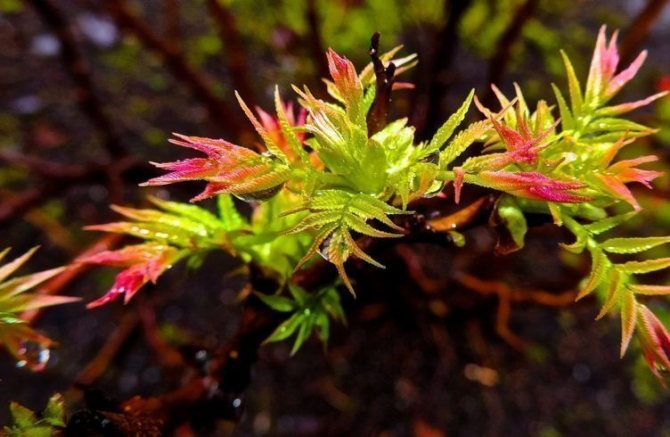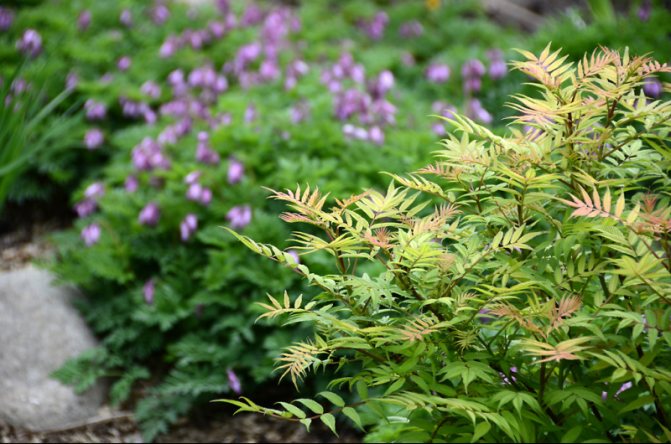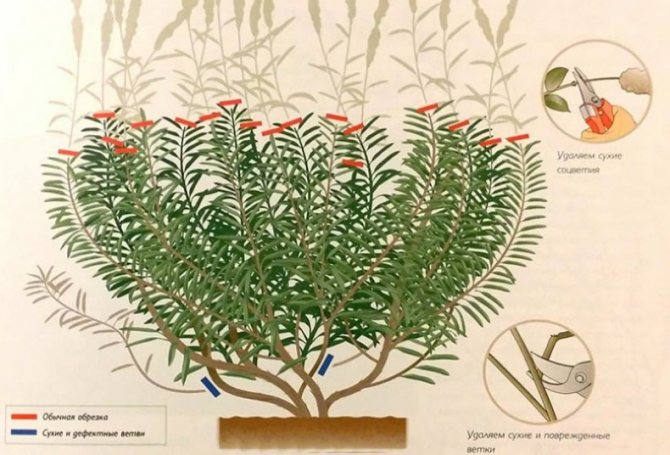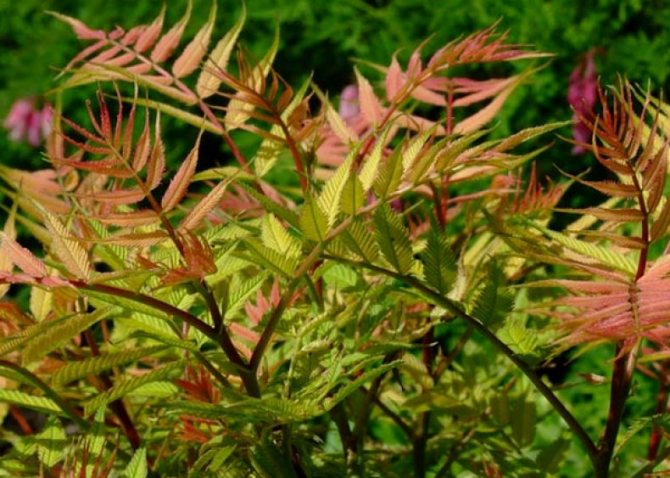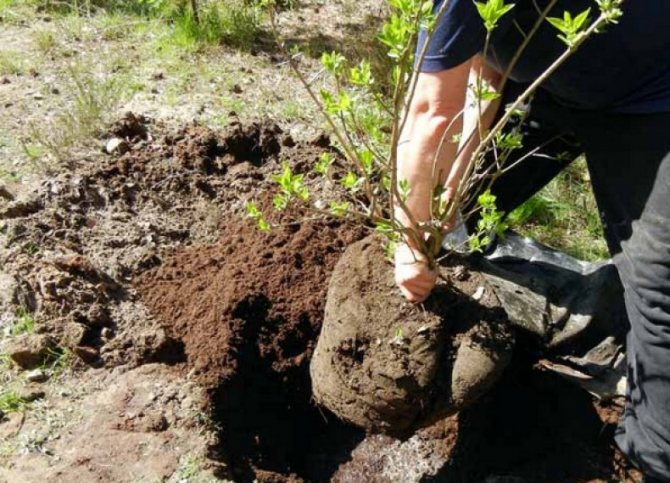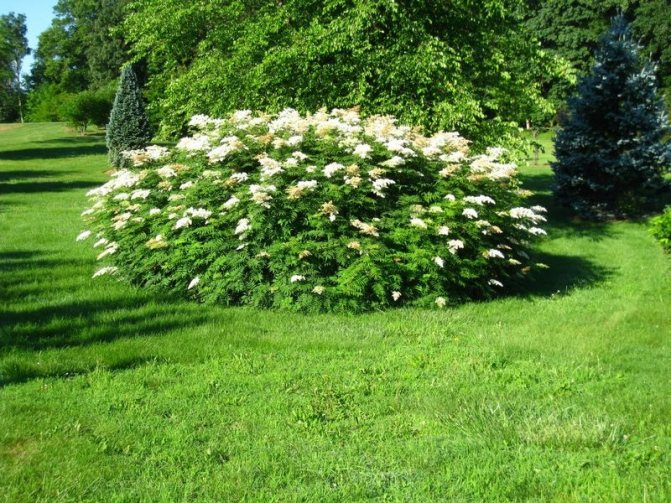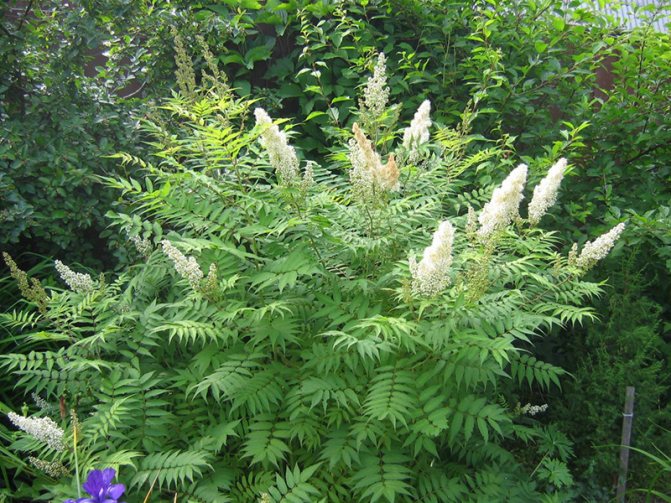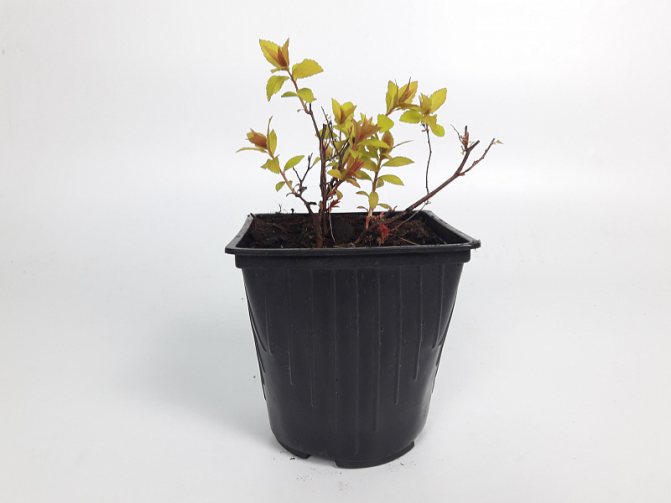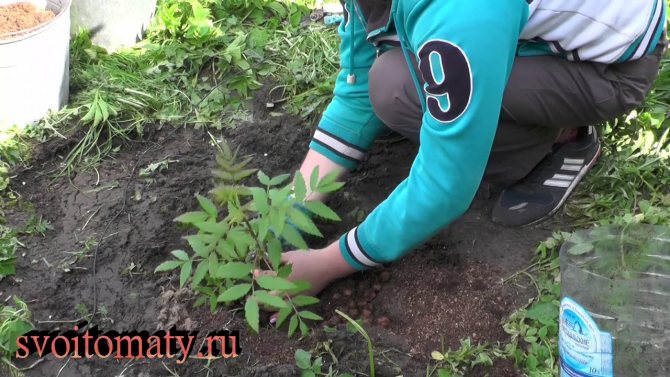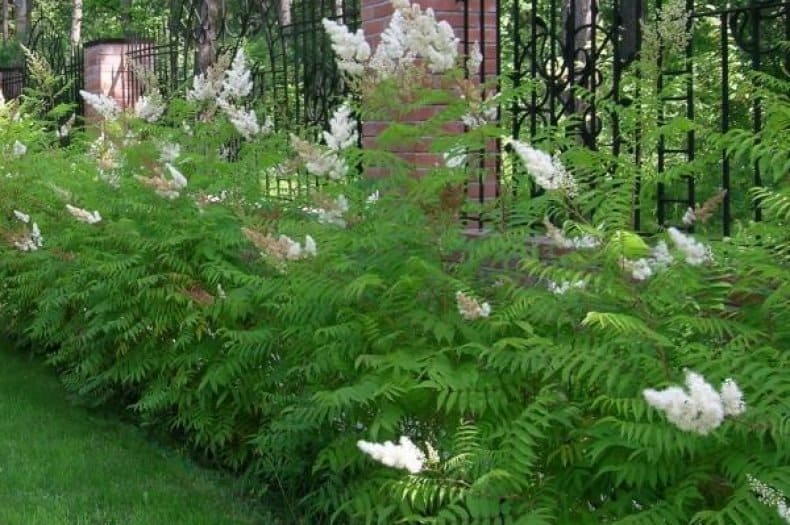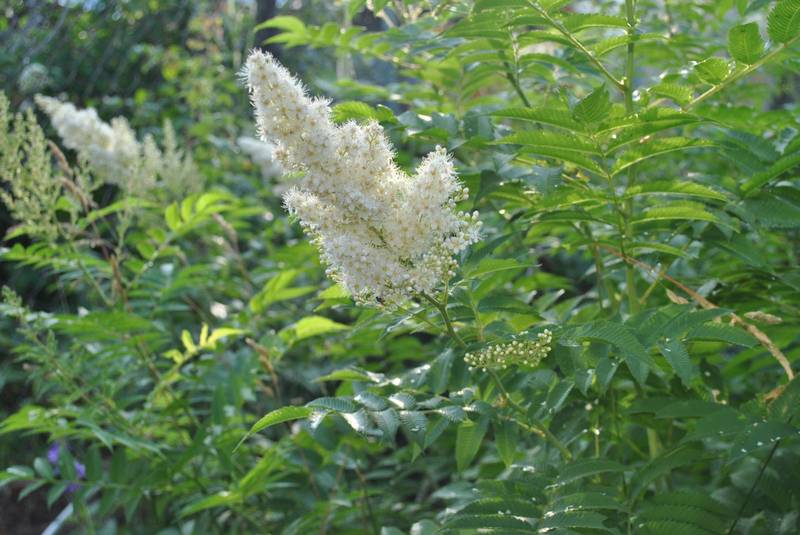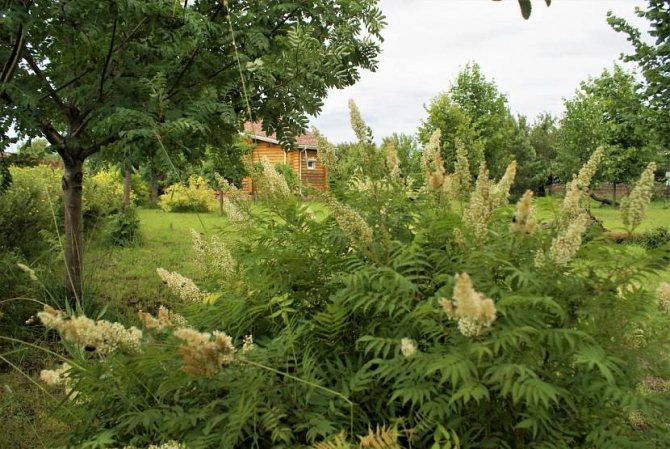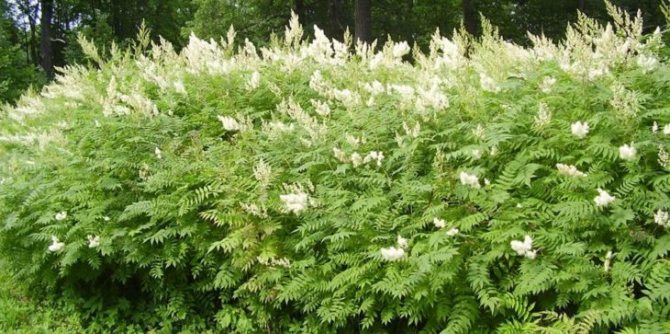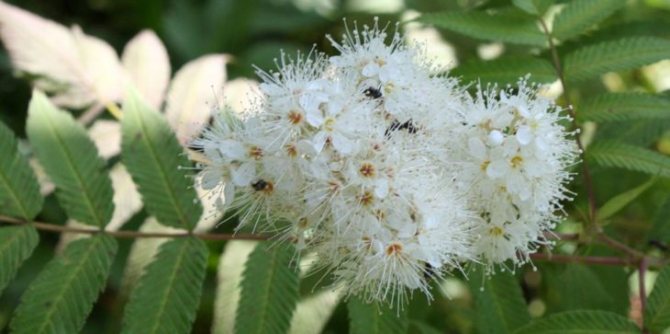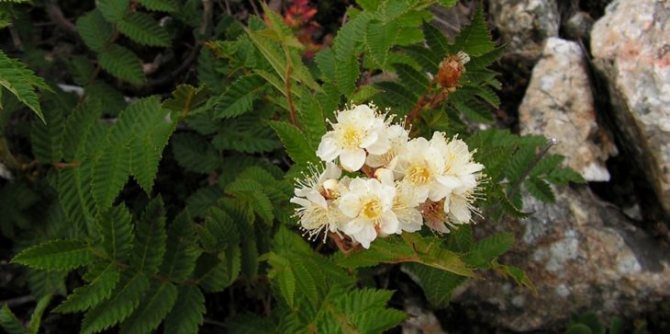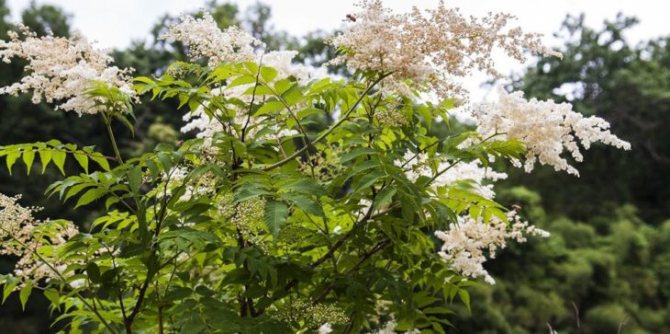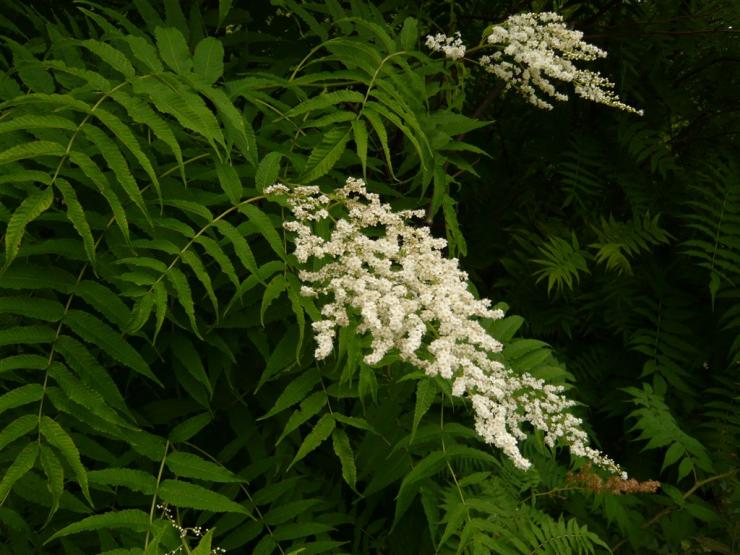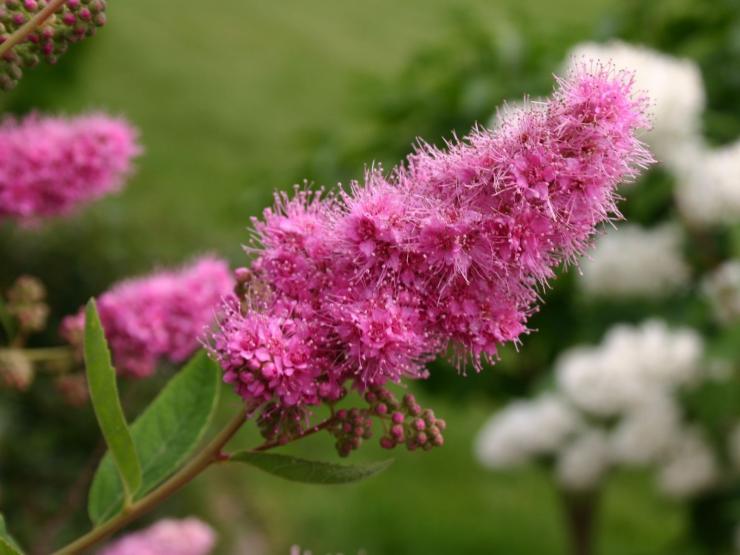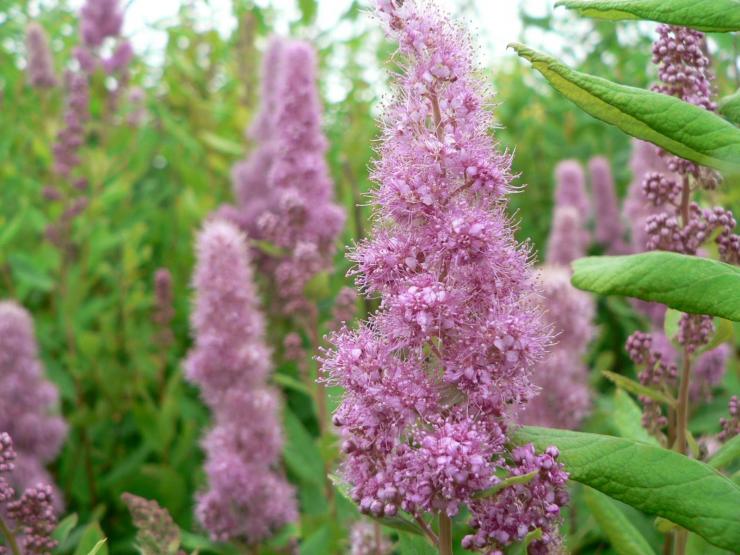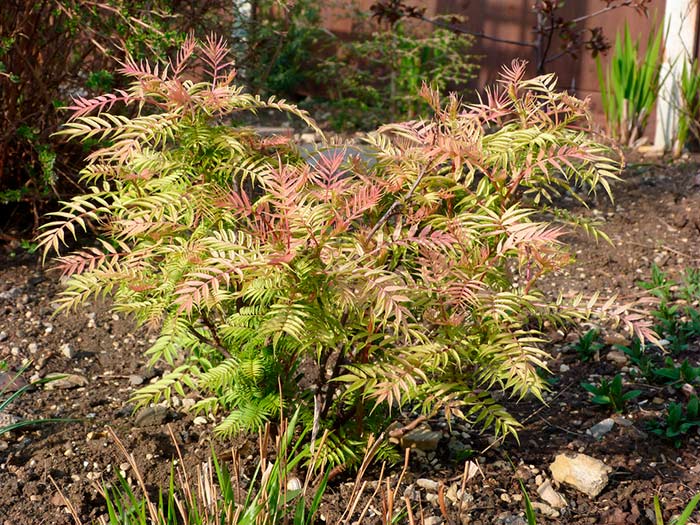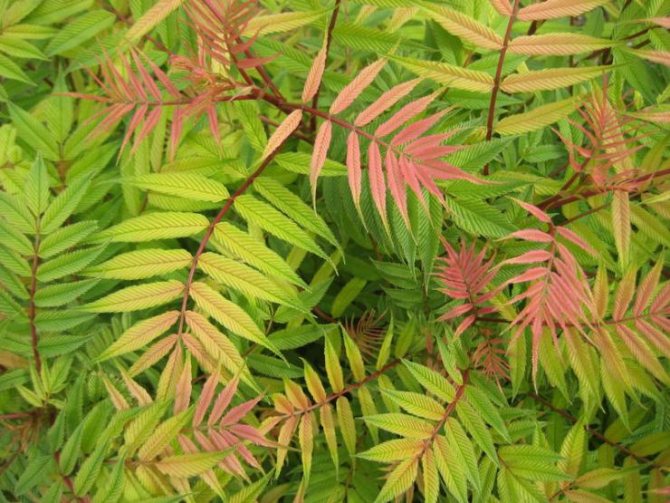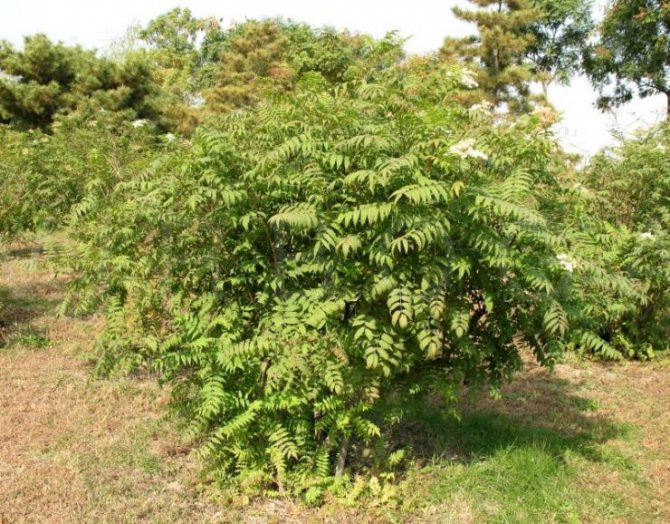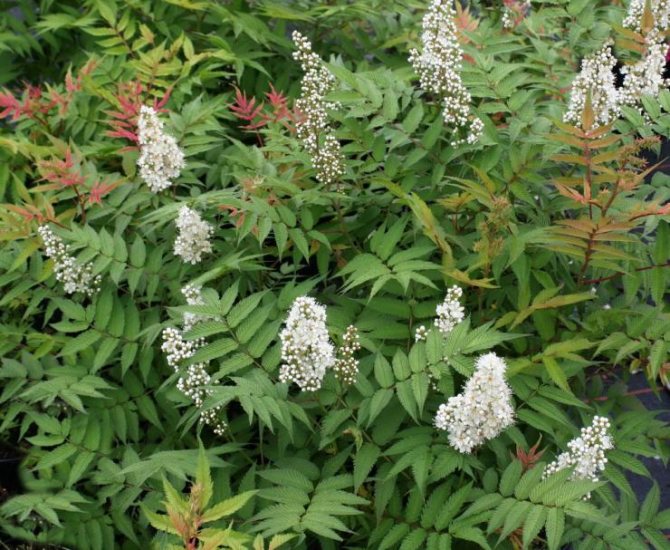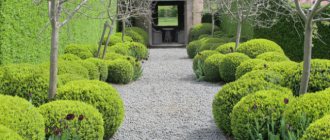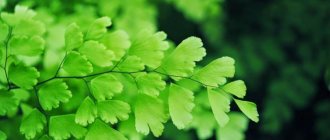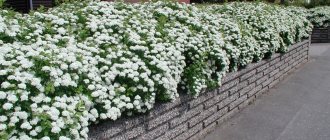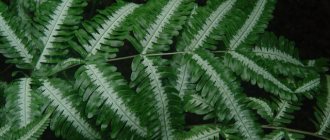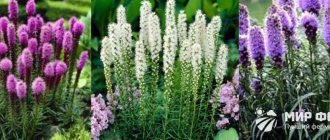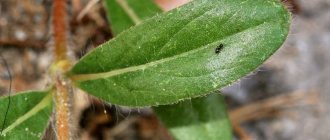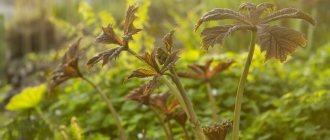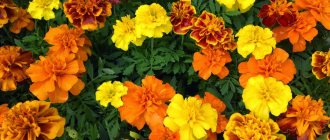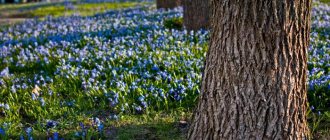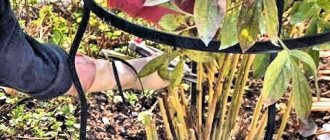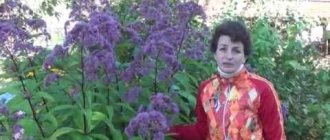The mountain ash-leaved field is a great option for the owner who wants to decorate his plot. The bush does not require special care and gets along in any garden area.
On the title photo: Black Elderberry "Black Lace", Fieldfare "Sam", decorative bow Allium christophii.
The shrub feels good when:
- Placed in shade or partial shade. Although planted in the sun.
- In severe drought or overflow. At the same time, the fieldfare loves frequent watering.
- When transferring. It quickly departs and is "accepted".
- When cutting and shaping a bush.
All this makes him a welcome guest in any garden. Fieldfare quickly begins to grow and delight with delicate flowers.
Important! Fieldfare is precisely a shrub, not a tree, so it does not exceed two meters in height. The trunk becomes stiff over time and does not require special support.
origin of name
In fact, if you go deeper into history, then fieldfare and spirea are not the same plants. They belong to the same Rosaceae family, but belong to the genus Spiraea i Sorbaria. The confusion between them arises due to the fact that once someone called the spirea mountain ash, and this name stuck in the minds of people. Although among the spirits there is a species that resembles a fieldberry, but such a name does not come at all from the origin of the plant, but from the people. Although the search engine shows information and photos at the request of Spirea Sorbifolium (rowan-leaved spirea), this formulation is incorrect.
Diseases and pests
Fieldfare is very resistant to pests and diseases. Occasionally a green aphid or a spider mite can take a fancy to it, then the shrub is treated with a solution of Fitoverma or Mitaka. Sometimes fieldfare gets sick with a viral mosaic. Unfortunately, this disease is incurable, and the affected plant will have to be destroyed.
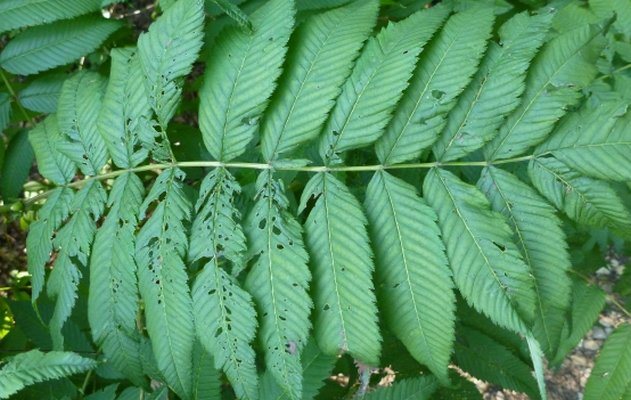
Botanical information about the plant
The crown is formed from unpaired leaves 10-13 cm long, outwardly resembling rowan leaves. The stems of the plant are thickened, straight, covered with gray-brown bark.
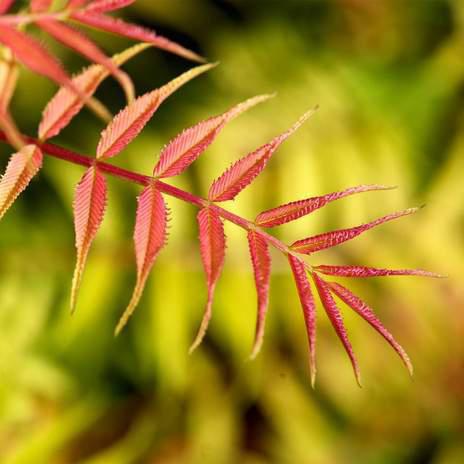

The life span of a healthy specimen is 25 years. In young trees, the foliage is pink, as the bush matures, it darkens and turns to a rich green shade. In the spring, when the plants are just beginning the growing season, the mountain ash spirea already pleases with its beauty. She sheds foliage closer to mid-October.
In summer, the flowering period begins and the bush is covered with white fragrant inflorescences, forming pyramidal panicles up to 25 cm long. At this time, the bush is unusually beautiful, for which it was attributed by gardeners to ornamental plants.
If flowers are dizzy with their appearance, then this cannot be said about fruits. They do not differ in decorativeness.
In the autumn, the foliage of the bushes acquires yellowish and purple hues.
For the first 4-5 years of life, mountain ash spirea reaches 3 meters in height and the same figure in volume.
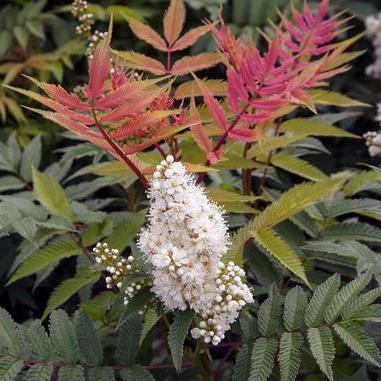

The plant is used in horticulture and landscaping to create hedges, group plantings, and strengthen slopes and slopes. The spirea has a well-developed root system, which makes it possible to plant on slopes in order to strengthen the soil. The bushes lend themselves well to transplanting, therefore they are suitable for growing not only in the country, but also in urban conditions.
Features of fieldfare
Fieldfare is a deciduous shrub that can reach a height of about 3 meters. He can form very beautiful dense thickets, because he has many root shoots. Cranked-sinuous stems are colored gray-yellow. The composition of odd-pinnate complex leaf plates includes from 9 to 13 pairs of double-serrate or serrate leaves. Pyramidal panicle inflorescences consist of many small flowers of cream or white color. The fruit is a leaflet.
Such a shrub in landscape design is used to create group and single plantings, and it is also used for hedges, for decorating ponds, and also for strengthening the slopes.
Growing features
Like other representatives of the flora, the mountain ash spirea has its own requirements for both care and planting. The cultivation of such plants is as follows:
- Plant shrubs in leafy or soddy soils. For the planting mixture, 1/3 sand, 1/3 peat and 2/3 earth are suitable.
- Don't forget about the drainage layer, use crushed brick.
- Plant plants in holes 1/3 more than the root of the seedlings.
- Planting depth - 50 cm. Make sure that the root collar is at ground level.
- The best time for planting is September, the weather is cloudy or rainy.
- Rowan-leaved spirea feels best in the vicinity of juniper, spruce, thuja.
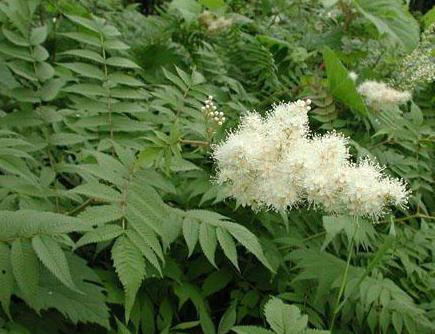

Site selection and soil preparation
This shrub is unpretentious, therefore, the gardener is almost unlimited in choosing a place for planting it: both sunny and shaded places (for example, under the canopy of trees) are suitable, he is not particularly picky about the quality of the soil. The best option for planting is fertile loam with soil acidity close to neutral (pH 6-7).
Important! The only requirement is soil moisture: the plant does not tolerate drought well.
How to provide proper care
It is surprising that a plant of such beauty is actually unpretentious. The bushes grow well and delight with abundant flowering under normal conditions. For this it is enough:
- plant spirea in a fertile area;
- systematically loosen the earth;
- provide illumination;
- prevent stagnation of water;
- apply top dressing three times per season, using a mineral complex;
- cover young specimens for the winter in order to prevent freezing of the shoots.
As you can see, it is enough just to follow the mountain ash spirea. Planting and leaving are no different in complexity. Although such features are not typical for all representatives of this species.
Landing
Due to the unpretentiousness of the mountain ash spirea itself, planting will not cause difficulties if you are careful when choosing seedlings and preparing them. The process itself is not time consuming, takes little time and does not require special skills from the gardener. It is best to plant the shrub in early autumn - in September. This is due to possible bad weather, which favorably affects the growth rate of the plant due to the strong moisture.
Important! Do not plant field grass right away: let the dug hole stand for 2 to 4 days.
Preparation of seedlings
If you decide to just start breeding rowan-leaved spirea, you will have to buy seedlings. Before purchasing, pay attention to the plant sold: the roots should not be too dry. The main feature of good shoots is their flexibility and the quality of the sprouted buds.
If after purchasing you find that the roots have grown too much, use a garden shears to prune them. It happens that, on the contrary, the rhizome is damaged or dried out - then wash it, leave it in a bucket of water and cut the stem itself before planting.
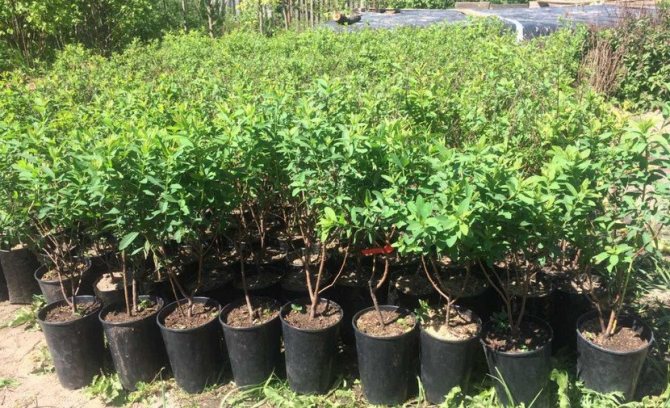

Soil preparation
In the area where the shrub will grow in the future, it is necessary to dig a neat hole with strictly perpendicular walls. Its depth and width should be at least a third more than the root system of the spirea.
For planting, choose rainy or at least cloudy weather. In the pit, first create a drainage layer that will occupy the excess dug depth in advance. The easiest way to make such a layer is from waste of building materials, for example, broken brick.
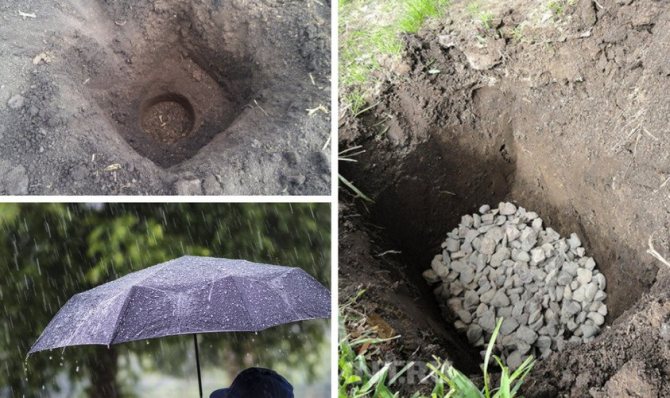

How to plant
After creating a drainage layer, it is advisable to add turf soil, sandy soil and peat to fertilize and increase the growth rate of the spirea. Next, just dip the roots of the bush into the hole. Lay them out carefully and sprinkle with earth. It is noteworthy that it is better to plant the plant before or during leaf fall: fallen leaves will protect the fragile shrub from frost and will fertilize it in the cold season.
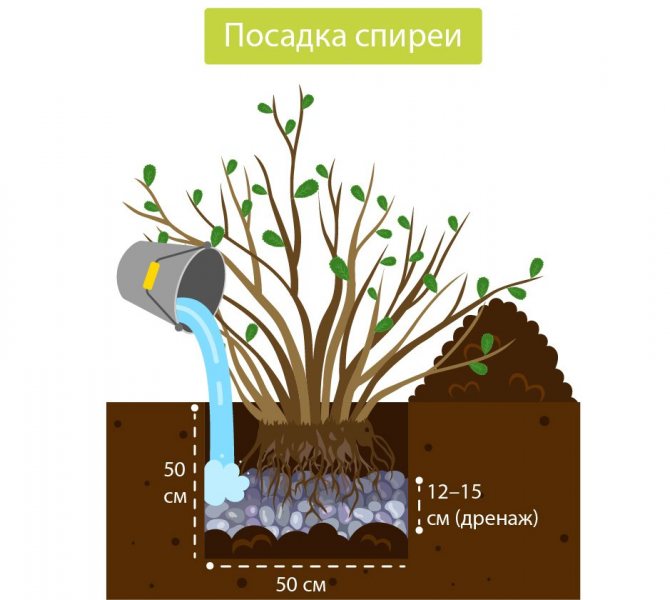

The subtleties of growing: pruning
This is the only feature that is important to keep in mind when growing spirea. Spring flowering plants require almost no pruning, except for sanitary purposes. With this procedure, old shoots more than 5 years old, damaged and shriveled branches that have not survived the winter are removed from the branches of the mountain ash spirea plant. Pruning is done almost immediately after flowering. At the same time, the faded processes are not touched. Summer flowering species are pruned starting from the fourth year of life, at a height of 22-30 cm from the ground. Having missed the right moment in order to rid the bush of excess, you will deprive the plant of decorativeness: the spirea will lose its correct crown shape, and the central branches may succumb to deformation and eventually sink to the ground. If only the tops are trimmed, the plant will produce delicate shoots and poor flowering.
Care
Let the mountain ash spirea and not a whimsical plant, however, it still requires some care. For active growth and subsequent survival of the plant, it is necessary to water and feed it on time.
To improve the decorative properties and appearance, you need to cut it off in a timely manner. Keep in mind that summer-flowering spirea varieties will not survive long without pruning: all the vitality will be transferred to the tall stems, depriving the roots of the nutrients they need.
Pay attention to another type of spirea - Little Princesses.
Watering and feeding
You need to water the bush regularly only at first after planting. Also, this need appears only in extremely dry weather. For a plant to live comfortably, it only needs 15 liters of water for two weeks, provided that the current season is summer. In rainy weather, it is better to refuse watering in order to protect the shrub from the possible start of the process of rhizome decay.
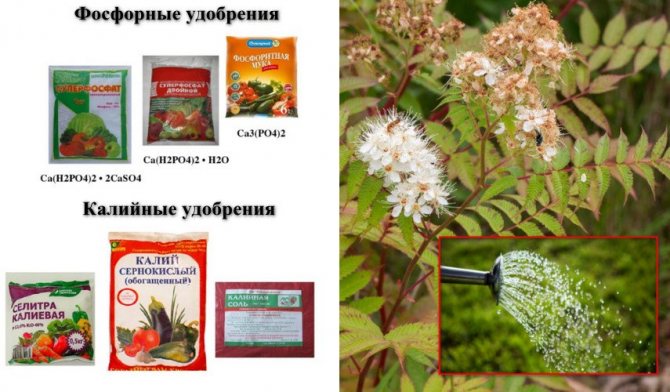

For lush flowering, gardeners use nitrogen-based fertilizing. For mountain ash spiraea, supplements are often used that contain phosphorus and potassium, as well as other special nutrients based on minerals. You need to feed the bush only in early spring, when the plant begins to recover after winter and intensively absorb food from the soil.
How to trim
There is a difference between pruning spring flowering and summer flowering varieties. In the case of the first, the shoots grow evenly, so you only need to cut off frozen and too high branches, if any. In the spring, once every two years, there is a need to remove old or thin stems. If the plant has been growing for a long time, cut off the old shoots completely every 7 years.
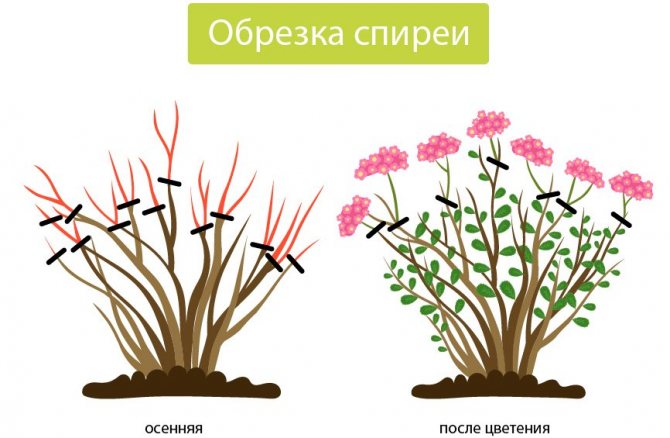

Pruning summer-flowering spirits should be done in early spring, when new leaves are emerging. All developed shoots must be shortened to the size of the largest buds formed. Weak branches should be removed completely.
Summer flowering bushes are not very durable. In this regard, it is necessary to completely remove them after 15–20 years of growth. After this period, the spirea will bloom worse and will begin to die off itself, while pruning will no longer help.
Important! After four years of growth of the summer variety, the shrub must be completely cut off at a height of 25 to 30 cm.
The place of the spirea in landscape design
Mountain ash bushes are spoken of as multifunctional elements of landscape decor. This is the best option for landscaping. Such popularity is due not only to the attractive appearance of the plant, but also to its extensive varietal variety. Some of the subspecies, due to their miniature form (60 cm), look attractive in rockeries. There are also group plantings made of bushes with different flowering periods. It is appropriate to use this plant both in mixborders and as hedges.
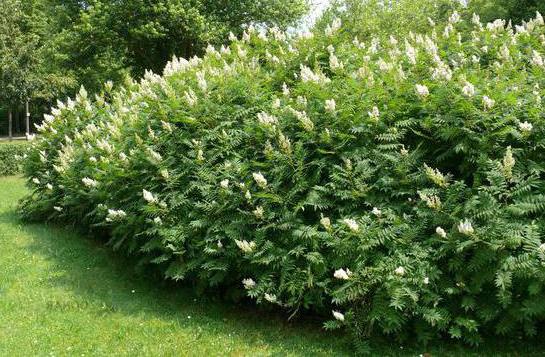

An excellent neighborhood of mountain ash is made by deytsia, derain, weigela, scumpia and most conifers.
As you already understood from the description, rowan-leaved spirea is an unpretentious, outwardly attractive and efficiently flowering ornamental plant in use. These features allow him to take pride of place among gardeners and designers. With spirea, the garden will instantly be transformed and filled with aroma.
Spirea Bumald
Low shrub, up to 75 cm tall, with a graceful, spherical crown and erect branches. Shoots are slightly ribbed, glabrous. Leaves up to 8 cm long, ovate-lanceolate, glabrous, sharply double-serrate. The color of the flowers varies from pale pink to dark clove pink. It blooms almost all summer, about 50 days. A very beautiful hybrid with highly variable characteristics, often difficult to distinguish from the Japanese spirea, usually below it and with more ribbed shoots. Prefers moist soils, regular watering is desirable.
Spirea Nippon Snowmound
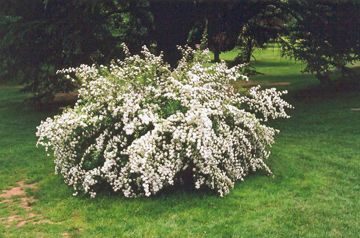

Spirea Nippon Snowmound is a dense, compact shrub, has a dense, broadly spreading crown shape, with skeletal, arched, gracefully bent shoots. Typically, the plant grows up to 1.5 m in height and width.
A distinctive quality of this plant is - elliptical dark green foliage up to 3 cm.Lives up to 50 years.
Abundant white flowers, up to 0.8 cm in diameter - matched in umbrella-shaped inflorescences.
The shrub is photophilous, frost-resistant, smoke and gas resistant, not whimsical to soil and moisture, but fertile and moist soils are required for the best development.
Rowan-leaved spirea
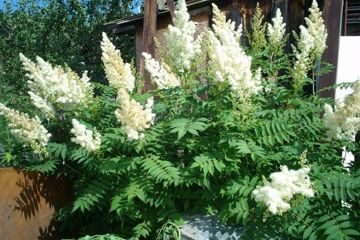

Mountain ash spiraea grows rapidly, usually reaching a height of 1.5-2 meters and the same width, thick stems, intertwining, form difficult thickets.
It is a frost-resistant, unpretentious shrub with high decorative properties. Large feathery leaves are similar to rowan leaves, young leaves are pink, eventually turn green. In July, numerous white flowers appear, collected in large panicles, flowering is long - about a month.
In autumn, the fieldberry foliage turns yellow or purple. The mountain ash is hardy and easy to grow. It is undemanding to soils, is able to grow in a wide pH range, prefers moist, well-drained soils, tolerates temporary flooding.
Drought-resistant, but responds well to watering. It tolerates urban conditions well. Removing the root overgrowth and pruning will help form a thicker shrub. Due to its unpretentiousness, it grows with success almost throughout the territory of Russia.
Spirea Japanese Dart's red
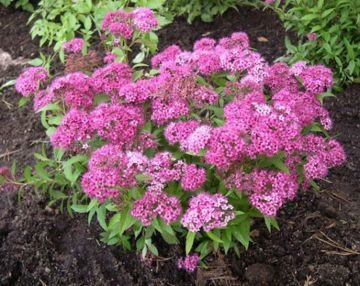

Low (up to 1m), dense shrub with erect shoots. Leaves dark green, with a reddish tinge when blooming. Flowers collected in rather large, dense corymbose inflorescences, dark amaranth, by the end of flowering do not fade, but retain a bright, reddish color. Long bloom (up to 60 days), from June. Grows best in a sunny place without shading. Prefers rich, well-drained soil and moderate watering. It can grow on poor soils with sparse watering, but it develops worse. In late autumn or early spring, a strong pruning of the bush up to 10-30 cm ("on a stump") is recommended. Hardy, no freezing.It is used to create compositions in mixborders and rock gardens, suitable for ridges and low hedges, single and group plantings on the lawn. After the fourth year of culture, it is recommended to cut off the entire upper part of the bush at a height of 25-30 cm from the ground every spring.
Spirea Japanese Gold Flame
A beautifully flowering shrub with a compact dense spherical crown up to 0.8 m in height and in diameter. Leaves when blooming are bronze-orange, then golden-yellow, in summer - greenish-yellow and in autumn copper-orange, 5-8 cm long. The leaves acquire a bright color in sunny areas, in the shade they turn green.
Flowers are carmine-pink, small, collected in corymbose inflorescences. Blooms from June to mid-August for 50 days, abundant flowering. Winter hardiness and drought resistance are high. Prefers moist fertile soils.
Planting fieldfare in the open field
What time to plant
Fieldfare is planted in open soil in early spring, before sap flow begins or after leaf fall ends in autumn. This plant is relatively shade-loving, so it can be planted under tall trees. It feels equally well in very wet soil and in clayey dense soil.
How to plant
The size of the pit for planting should be approximately 0.7x0.7 m, while its depth should not be more than 0.5 m. If you are creating a group planting, then the distance between the specimens should be at least 100 centimeters. The fieldfare is similar to the blackthorn in that it can grow rapidly, capturing all new territories, so it is recommended to overlay the sides of the planting hole with slate or metal sheets. A good drainage layer should be made at the bottom of the pit. It needs to be covered with a layer of soil mixture, consisting of soil combined with humus or compost. Then the root system of the seedling must be placed in the hole, and covered with soil combined with organic matter. During planting, make sure that the root collar of the plant rises above the surface of the site by 20-30 mm. The planted shrub must be watered, while 20 liters of water are poured under it. When the liquid is completely absorbed into the ground, the surface of the trunk circle will need to be covered with a layer of mulch.
Botanical reference
Fieldfare (sorbaria) belongs to the Pink family. Its Latin name comes from "sorbus", which means "mountain ash" in Latin. If we consider the leaves of a shrub, then the similarity with the leaves of a well-known tree is obvious. They are 20-30 cm long, pinnate, with 9-15 pairs of leaflets.
In my opinion, their flowering is similar. Only mountain ash blooms in spring and has corymbose inflorescences, and field ash - in summer and acquires panicles. The small flowers themselves are similar, a little fluffy in appearance due to the long stamens with anthers.
Fieldfare and mountain ash. Photo by the author
There are 10 species in the genus that grow in Asia. The maximum height of fieldfare is 6 m, but those 5 varieties that are more or less common and used in horticulture do not grow higher than 3 m.
Almost all fieldfare annually give many root suckers and thus create picturesque thickets. They bloom very profusely for 30 days and attract a variety of insects in large numbers. Despite the available varieties, as a rule, only a few species are used in gardening.
Field care in the garden
Caring for fieldfare is quite simple, and even a beginner can handle it. Remember that the soil near the bushes should always be slightly damp and loose. Provide him with timely removal of root shoots and weeds, and feed regularly (when grown in poor soil). Formative pruning is done only when necessary.
Watering should be plentiful, especially if there is a prolonged drought.Top dressing is carried out in small portions at least 2 times during the season, while the nutrient mixtures are shallowly embedded or applied superficially. The shrubs are fed with compost, peat or humus, in some cases, complex mineral fertilizers are also used.
In order for the appearance of the plant to always remain as effective as possible, it is necessary to promptly cut off the inflorescences that have begun to fade. At the very beginning of the spring period, sanitary pruning is carried out, for this you need to cut out all injured, damaged by pests or diseases, dried branches, as well as those that thicken the bush. If you do not thin the bush, the stems will become thinner, weaker, and they will age very quickly. Fieldfare tolerates pruning well, even rejuvenating. Remember to cut the root growth systematically.
Transfer
The shrub tolerates transplantation very well. This procedure is very often performed together with the division of the bush. The preparation of a new planting pit should be done in autumn or spring. A drainage layer should be placed at its bottom, and a soil mixture should be prepared, consisting of soil removed from the pit, as well as compost or humus. Remove the bush from the ground, and, if necessary, cut it into several parts, while taking into account that each delenka should have powerful shoots and well-developed roots. Places of cuts should be sprinkled with crushed charcoal, then the cuttings are planted in new places. If you do not divide the bush, then the dug out plant will need to be placed in a planting hole, which is filled with prepared soil mixture. The soil around the shrub is compacted, and then abundant watering is carried out.
Fieldfare propagation
Such a plant can be propagated by dividing the bush, this procedure is described in great detail above. Theoretically, fieldfare can be propagated by seeds, but in practice, seedlings appear very rarely. Most often, gardeners propagate this shrub with lignified cuttings and layering.
It is very simple and easy to propagate fieldberry by layering. In springtime, it will be necessary to choose a strong, healthy and long stem, and bend it to the surface of the site so that several buds are in contact with it. Then the stem is fixed in this position and covered with soil, while its top should remain free. Do not forget to water the cuttings in a timely manner in the summer. After a few weeks, the cuttings will take root, and in late summer or early autumn it can be cut off from the parent plant and planted in a new place.
Read also How our great-grandmothers kept food without refrigerators
Cuttings are cut from lignified stems, while the length of the apical segments can vary from 20 to 30 centimeters. For rooting, they are planted in a box filled with earth mixture. Keep the soil slightly damp at all times. If the cuttings root successfully, their tops should begin to grow.
Diseases and pests
Such a shrub is distinguished by high phytoncidal properties, which explains its resistance to diseases and pests. Very rarely, green aphids or spider mites can settle on it. Such sucking insects suck out the plant sap from the bush, as a result, it becomes lethargic, and the stems are deformed and the foliage turns yellow. In addition, there is a high probability that such pests will infect the fieldfare with a viral mosaic. Such a disease cannot be cured, and therefore all you have to do is dig up and destroy the plant. To get rid of such insects, they resort to treating the affected specimen with Fitoverm or Mitaka solution.
Fieldfare Pallas
This plant (Sorbaria pallasii), on the contrary, is the lowest of the fieldfare. Its height is no more than 120 cm, more often up to 80.
Fieldfare of Pallas blooms. Photo by Galina Chulanova from the site
It blooms in small, obovate clusters ranging in size from 2 to 8 cm. Compared to other species of fieldfare, the individual white flowers of this variety are quite large - up to 1.5 cm in diameter.
Despite its endurance and early maturity (seedlings bloom already in the first or second year), they are rarely used in design. The main disadvantage is the fragility of the trunks, which requires their regular removal.
Types and varieties of fieldfare with photos and names
Only 4 species of fieldfare are cultivated:
Felt fieldfare (Sorbaria tomentosa)
This species is native to East Asia. In height, such a plant can reach 6 meters. A shrub in nature prefers to grow on mountain slopes. It does not bloom. Possesses low cold resistance.
Field ashberry (Sorbaria arborea)
Found naturally in East Asia. The height of such a shrub does not exceed 6 meters. Such a slow-growing plant is highly frost-resistant. Flowering is observed in July – August.
Fieldfare Pallas (Sorbaria pallasii)
This plant can be found in nature on the rocky slopes of Transbaikalia and the Far East. The height of this spectacular mountain ash does not exceed 1.2 m. The color of young stems is brown, they are glabrous or thinly pubescent with branched light yellow hairs. Old stems are covered with peeling bark. Unpaired linear-lanceolate leaf plates reach 15 centimeters in length, as a rule, on their surface there is pubescence, consisting of hairs of a red color. Not very large apical panicle inflorescences consist of white or cream flowers, the diameter of which is 1.5 cm. The fruit is a pubescent leaflet. This shrub is winter hardy.
Fieldfare mountain ash (Sorbaria sorbifolia)
This type is most popular with gardeners. In the wild, it forms thickets on the river banks and forest edges of the Far East, Korea, Siberia, China and Japan. The height of the bush does not exceed 200 centimeters. The color of straight stems is brown-gray. The length of the sharply serrated unpaired leaf plates is about 0.2 m, they have a pointed apex. When the leaf plates are just blooming, they have an orange-pink tint, in the summer their color is pale green, while in the fall it changes to carmine red or yellow. The length of the pyramidal panicles does not exceed 0.3 m, they consist of fragrant cream-colored flowers. They have very long stamens, making the inflorescences look fluffy. The fruit is a fused jug-shaped leaflet.
The mountain ash shrub is a plant that is successfully used to decorate a hedge, in addition, it has a very pronounced decorative effect. The fieldfare is widespread due to its beauty and unpretentiousness. However, caring for him has its own characteristics.
Mountain ash
This species of field ash (Sorbaria sorbifolia) is a real favorite. It is readily used in the design of gardens. It grows up to 3 m in height and actively builds up erect shoots, giving a good growth every year. Large odd-pinnate leaves about 25 cm long are very reminiscent of mountain ash, hence the double mention of the tree in the name.
Young leaves on it can be seen in early spring, the bush is one of the first to wake up. Blooming shoots turn pink at this time. Later, the plant is covered with light green leaves, and in autumn the color changes to red and yellow. The mountain ash-leaved field is decorative all season.
Fieldfare leaves in early May. Photo by the author
At the time of flowering, and this happens in July, the bush is covered with numerous fluffy and long (up to 30 cm) panicles of white flowers. It is an excellent honey plant and attracts a large number of pollinators, including beetles.
Reproduction
For reproduction, in addition to dividing the shrub itself, seeds and the method of cuttings are also used. Each of the methods has its own characteristics. For example, with the help of seeds, it will be possible to successfully grow only non-hybrid spireas: with such reproduction, the plant does not retain the characteristics of the variety. When cuttings are cut, two-thirds of the plants successfully adapt to the new place. Spring-flowering fieldfare is cut at the very beginning of summer, and those that bloom in summer - at the beginning of July.


To obtain a cutting, it is enough to correctly cut off a young shoot of a bush, on which there are at least 5 leaves. The lowest sheets must be cut off completely, and the rest must be cut in half. After that, sprinkle the formed knot with a stimulant, for example, "Kornevin", which can be purchased at a specialized store.
Learn also about another variety of spirea - Magic Carpet.
Plant the finished cutting in a pot of wet sand at an acute angle of up to 45 °. Then cover the plant with a transparent material: glass or plastic. Caring for the cuttings is simple: twice a day you need to spray it with a small amount of water, and with the onset of cold weather, cover it with fallen leaves. By spring, the plant will be ready to be transplanted into soil.
Planting mountain ash spirea is not difficult if you follow simple recommendations. The plant is unpretentious in care and will delight with its flowering for more than one year.
Growing mountain ash
Truly, the mountain ash is a very easy plant to care for. Easily propagated by root suckers, layering and lignified cuttings, it is more difficult to grow from seeds.
The place of growth is not very important, this plant will feel good both in the shade and in the sun. However, it is preferable to place it in partial shade on moderately moist rich soils. It is best to plant fieldfare in a permanent place in the spring. The first time requires attention: timely watering, weeding.
As a rule, this plant is not susceptible to diseases and attacks of pests, which is another plus in favor of starting it on your site. However, there is also a certain danger here. So, if the bush nevertheless turned out to be affected, the owner does not always attach due importance to this in time.
A six-year-old mountain ash bush in June. Photo by the author Pests that can attack the fieldfare create problems for many other plants. These are aphids and spider mites. Aphids are easy to spot. The spider mite manifests itself as white dots on the leaves. You can get rid of parasites with insecticidal agents, of which many are on sale.
The disease that occasionally affects the fieldfare is a viral mosaic. It is impossible to get rid of it completely, but there are means to minimize harm. In addition, it is worth remembering that, as a rule, an oppressed plant with low immunity suffers from such a disease.
How to care for an ornamental shrub
As noted above, the fieldfare is not capricious and does not require careful care, but it will thank you for a small amount of attention, revealing its beauty in full.
How to water a plant
The fieldfare does not tolerate prolonged drought, but it is very moisture resistant, easily withstands slight flooding. Therefore, when watering, it is better to overdo it than to be careful and regret water for the bush. Immediately after planting and the first year, watering is often and abundantly.
With further care, root watering is sufficient 2-3 times a month (in hot dry weather, it is worth increasing it). If direct sunlight does not fall on the plant (or after sunset, if the plant is in the sun), you can douse the leaves with water - it loves high humidity.
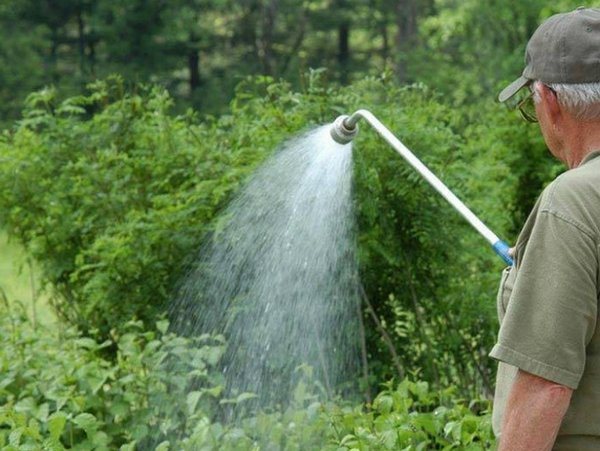

Weeding and loosening
Deep weeding of field ash is contraindicated, since it has a developed non-deepened root system.The first year of life, you can help him fight weeds, then he will cope on his own. To avoid drying out the soil, it is worth mulching it with peat or bark several times a month after loosening the trunk circle.
Top dressing and fertilization
Since the shrub has a developed green mass, moreover, it is renewed during the season, it requires regular feeding. You can limit yourself to organic fertilizers: peat, humus, compost; you can add mineral fertilizers: urea (in spring, about 40 g / m2); potassium nitrate (about 15 g / m2); superphosphate (in early autumn, about 40 g / m2).
Important! The fieldfare does not tolerate deep weeding, therefore fertilizers (both organic and mineral) are applied either directly to the trunk circle, or shallowly embedded when loosening the soil.
Shrub pruning
In the third year, it's time to prune. First of all, cut dry, broken, diseased and creeping branches on the ground. To shape, remove those branches that go beyond the projection of the shrub. Shaping haircuts are carried out throughout the season.
When using a shrub as a hedge, you will have to cut it 3-4 times per season. In addition, you will need to pay attention to the root growth, which tends to grow, and the hedge may lose its shape.
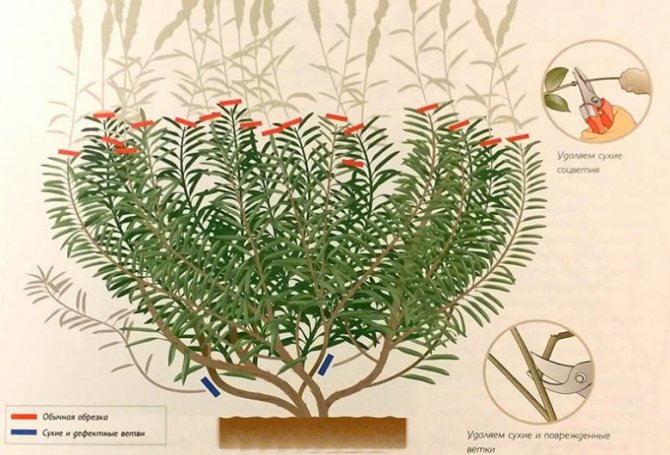

Fieldfare mountain ash in the design of the garden
Considering the above, we can conclude that this ornamental shrub is very beneficial to have in your garden. It has an attractive appearance, blooms profusely and beautifully, multiplies easily, is a good honey plant, and is also undemanding to care for and shade-tolerant.
Blooming fieldfare attracts insects. Photo by the author The fieldberry can be a bright accent in the garden. Usually it is used in group plantings, but a single placement on the lawn is also possible. However, in this case, it is necessary to take into account the active appearance and spread of the growth. This can be solved once and for all by burying a protective ring around the planted plant, since its roots are not located very deep. Root shoots of mountain ash. Photo by the author
From the fieldfare of mountain ash, an excellent hedge is obtained. It can replace hawthorn, cotoneaster or thuja. The fieldfare grows quickly and tolerates a haircut well, so many choose it precisely as a plant for a green fence or backstage.
Fieldfare is rowan-leaved. Photo from archiland.biz
This shrub is well suited to being adjacent to a reservoir. On the one hand, it will not suffer from a lack of moisture, and on the other hand, it will help to strengthen the soil on the shore, since the root system is dense. For the same purpose, it is planted on the slopes.
Growing up, this shrub covers garden corners well, even shady ones. In group plantings, fieldfare looks interesting together with various types of spirits, especially yellow-leaved ones. White flower panicles favorably set off conifers. In general, fieldfare looks very natural, "natural", so it is suitable for any informal style.
Find on your site a place for this wonderful shrub, modest in its unpretentiousness, but can become an excellent member of the garden "family" of ornamental plants.
Preparing field ash for winter
This plant tolerates even severe frosts well, therefore it does not need special insulation.
The number of unpretentious shrubs for the garden includes: spiraea, mock orange, viburnum, wild rose, forsythia.
Plants advantages
The plant dissolves leaves early and blooms for a long time. This species of mountain ash grows in places such as forest edges or river banks. It is due to them that large and dense thickets are formed.
The most common places where field ash grows are:
- Siberia;
- Japan;
- Korea;
- Mongolia:
- China.
Total this shrub can grow up to two meters in length
... The color of the culture is brownish-gray.The difference between this plant and the true mountain ash lies in the fact that the leaves of the shrub have sharp-edged edges. The top of the leaf has a sharper appearance.
In the spring, when the fieldfare blooms, an openwork-type crown with a pink tint is obtained. As for the summer period, the shrub acquires a green foliage color. In autumn, the field ash is red.
Pest control when growing irgi
Such adversities usually bypass the fieldfare. In rare cases, the shrub can be attacked by green aphids or spider mites. "Fitoverm" or "Mitak" are used against pests.
Very rarely, fieldfare can suffer from a viral mosaic. The disease is not treated, the affected plants are destroyed.
Pests:
- Irga moth (caterpillar) spoils foliage;
- currant leafworm eats foliage;
- birds: mainly fieldbirds and some other small birds, sometimes mice.
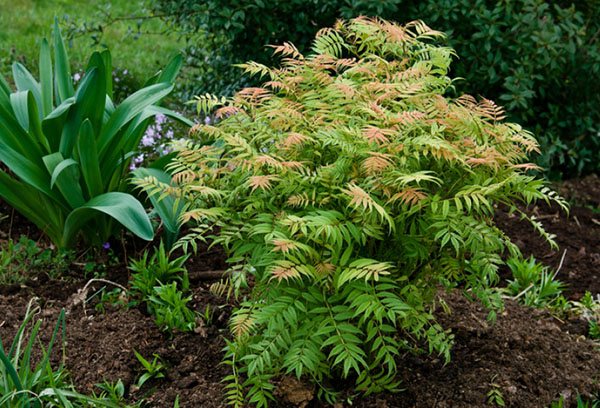

When processing is used - "Spark double effect" (1 tab. - 10 g per 10 liters of water). You can also add a little tar soap there, and then process the foliage of the tree.
Different, rustling and noisy bright visual scarers help from birds. They can be hung on a tree (plastic bags, empty cans).
If you do not water the game in dry weather, the fruits will be dry, small and firm.
The fieldberry juice contains phytoncides, thanks to which this plant rarely gets sick and is almost never attacked by pests.
Most often, problems arise from aphids and spider mites. These insects drink the juices of the plant, which is why it dries up, the leaves turn yellow. In addition, aphids carry diseases, and among them a viral mosaic that cannot be cured, and if a lesion occurs, then the bushes need to be burned and the area disinfected.
Botanical description of the species
A distinctive feature of fieldfare is its early flowering. At a time when green leaves are only blooming on other plants, yellowish-white "panicles" with a pleasant aroma appear on the mountain ash. The bush got its name for the complex, carved leaves resembling rowan foliage.
A plant with high winter hardiness, without shelter can withstand frosts down to -30 ° C. It grows on poor, clayey soil, but is picky about moisture. Without watering, during prolonged drought, it can die. In nature, the fieldfare bush can be found along the banks of rivers, on forest edges.
The fruits of this shrub have no decorative appearance. and any nutritional value, so many gardeners remove the inflorescences as soon as they begin to wilt. The roots are shallow, shallow, but grow strongly in width, have many branches.
Cutting fieldberry on video
One of the most time consuming aspects of fieldfare is pruning. How to do it correctly - in the video from the Sadovy Mir channel.
Ryabinnik (Sorbaria
)
- shrub up to 3 m tall. Mountain ash is usually used in landscaping. It grows rapidly, forming lush thickets. It blooms in mid-summer with small white flowers, collected in fluffy pyramidal inflorescences. In autumn, the leaves turn red and yellow. It is an undemanding shrub that can grow in partial shade. Reproduction of fieldfare is possible by seeds and offspring.
There is a variety Sem - a plant up to 1 m tall, when blooming, the leaves are pink-yellow, later green. Less aggressive than the species.
The fieldfare looks good on forest edges and near water bodies. Suitable for decorating large spaces.
In this article, we will talk about the intricacies of growing, as well as provide a detailed description of the mountain ash-leaved fieldfare.
Where and with what to plant fieldfare
The mountain ash is suitable for hedges, single and group plantings, design of reservoirs and fortification of slopes. It is quite shade-tolerant and can be used for planting under trees (, aspen) and next to dark conifers.The plant normally tolerates excess soil moisture and feels good on dense clay soils, therefore it is indispensable for damp and shady areas.
Fieldfare varieties.
Sem
- compact, up to 1.2 m tall, with a neat rounded crown. Young shoots are greenish yellow, young leaves have a reddish or copper tint, then turn golden yellow. The flowers are white, gathered in panicles. Suitable for tamping larger bushes and creating curbs. Requires brighter lighting than species plants to maintain decorative leaf color.
How to plant a plant correctly
Planting mountain ash in the open field does not present any particular difficulties. But in order for the plant to grow actively and look decorative, some details should be taken into account:
- The fieldfare, even if it is provided with minimal care, feels good both in the sun and in shade. The ideal location for the landing is the eastern side of the site.
- All varieties of fieldfare love moist soil. However, everything should be in moderation. Growing a plant in swampy areas is fraught with disease, and even death. In any case, a drainage device is required.
Advice. In the soil, in the place where planting will be carried out, it is advisable to apply organic fertilizer in advance. This will accelerate the growth of fieldfare.
Directly planting a bush is as follows:
Attention! It should be borne in mind that mountain ash has the ability to grow uncontrollably. Therefore, it is advisable to install root restraints immediately after planting.
Description of the species
The mountain ash-leaved field is a shrub 1–1.5 m high, of the Rosaceae family. An excellent honey plant, in nature it grows along the edges of the forest, along the banks of rivers. Complex, pinnate leaves vaguely resemble rowan leaves, for which the shrub got its name. Flowers are yellowish-white, fragrant, collected in pubescent pyramidal inflorescences, bloom in June.
Fieldberry fruits do not have nutritional and decorative value, therefore inflorescences ("panicles") are removed after flowering. High winter hardiness allows the shrub to withstand temperatures down to –30 ° C.
It can grow on dense clayey and poor in composition soil. It is demanding on moisture, it will withstand a short-term drought, but it can die from a long one. In hot weather, watering is required, from a lack of moisture, the shrub becomes stunted, the leaves become smaller and lose their decorative effect.
Easily adapts to shading, can grow under tall trees. It develops quickly and easily withstands transplantation. You can propagate fieldbus by dividing the bush, cuttings and layering. Planting with seeds does not give a good result.
Pruning
In the 3rd year of the life of the culture, starting in March, it is necessary to carry out sanitary pruning of young and mature bushes annually in order to form a beautiful neat crown. Frozen and broken branches are subject to pruning. It is also better to remove the shoots located close to the ground, and in the fall, to maintain shape and active growth, trim the panicle flowers.
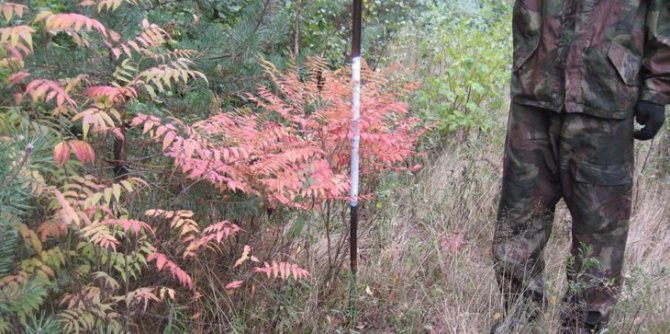

Rejuvenating pruning is also necessary to ensure that an overgrown plant stops throwing out thin, weak branches. They age very quickly, rot and deteriorate decorative properties. For many gardeners, the clearest and clearest signal that pruning is needed is drying tops and dropping leaves at the bottom of the branches. In this case, the diseased processes are cut off completely using a sharp disinfected knife or pruner.
Let's remember the most important information ...
- Rowan-leaved is a deciduous shrub with good winter hardiness (up to -30 degrees). Landscape designers appreciate it for its lush white brushes of flowers.
- You can plant a plant in early spring or late autumn. The shrub will not be intimidated by either a shaded area or a wet lowland with "heavy" soil.
- Taking care of the bush is easy.It should be fertilized a couple of times, watered (if the weather is dry), and pruned in the spring, since new branches will constantly grow from the roots. If you want to work less with garden scissors, plant field grass Sam - in terms of unbridled growth, he is the most humble.
Did you know that in our country there is also a field bird? We bet you didn't know what she looks like? Small, grayish, she just loves to peck frozen berries, and in summer she will not refuse fresh cherries. This is what this cute little bird looks like:
Care: fertilizing, watering, pruning
The soil around the shrub should be kept moderately moist and loose. There should be no weeds near the plant.
Fieldfare responds well to any kind of organic matter: humus, peat, compost.
It is not recommended to dig up the near-trunk circle, therefore fertilizers are applied superficially or under a shallow embedment. Fieldfare is fertilized at least two to three times per season, in small portions. Weeding is only necessary at the beginning.
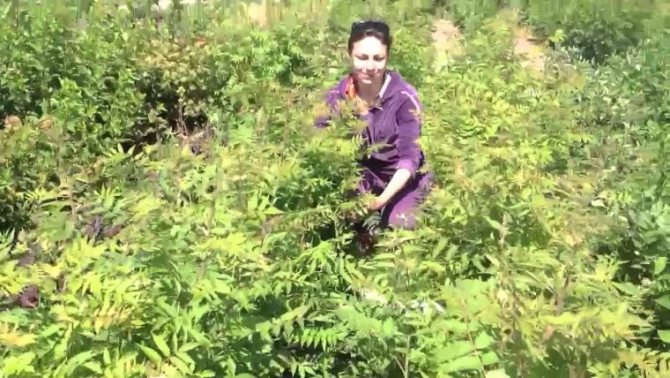

But if you want the hedge to be no more than 1 m, then annually in the spring, carry out a formative pruning of the bush. This will not affect the flowering of the bush, because flowers appear on the growth of the current year.
You only need to cut off faded inflorescences. This can be done in early spring: cut off the old inflorescence to the largest bud.
By pruning the shrub, you can adjust the height and width of the plant by shortening the shoots to the desired length.
Why the fieldberry does not bloom
Normally, rowan-leaved fieldfare pleases with flowering every year, even the harsh growing conditions do not violate its vegetative cycle. However, for a number of reasons, flowering may not occur or be too modest and unobtrusive.
- First of all, the presence and abundance of flowering depends on the variety and variety of mountain ash-leaved shrub. For example, a felt shrub native to East Asia does not bloom in principle, if just such a plant grows on the site, then you can not expect decorativeness from it.
- The lack of flowering may be due to severely disturbed growing conditions. If the plant grows on too dry soil, does not receive any nutrients and, moreover, does not undergo regular pruning, its decorative effect may suffer - the mountain ash-leaved shrub will have nowhere to take resources for beautiful flowering.
The attractive appearance of field ash is greatly spoiled by already faded and dried inflorescences, they do not allow new flowers to develop and reduce decorativeness. Therefore, it is recommended to delete them without fail.
Aphids are the main pest
The plant is resistant to diseases and pests. The main harm to young shoots can be caused by green aphids that feed on plant sap. This can cause the leaves to curl up and dry out the tips.
On the back of the leaf, a putin tick can settle. Pests are fought with phytoverm solutions (30 ml of composition for ten liters of water) or mitak (about 20-30 ml of substance per ten liters of water).
The leaves are processed twice. Infusions of garlic, onions and dandelions are good for aphids (1 to 5).
When a plant is damaged by a viral mosaic, yellowish-white spots are formed on the leaves. This disease is not cured, therefore, with a strong defeat, the diseased plant is destroyed.
Varieties, varieties
There are many varieties of fieldfare besides sorbaria sorbifolia
(in Latin it is the fieldfare of mountain ash).
The rarest of the existing - felt type of shrub
... You can meet a felt bush in East Asia. In Russia, the felt type is not used in landscape design - it does not tolerate cold well and does not bloom. However, it is the tallest variety of field ash, which reaches six meters in height and grows in highlands.
tree-like,
as well as the fieldfare felt, originally from Asia. Not common, but in landscape design it is still used, albeit rarely.It grows slowly, but, unlike the felt variety, it is frost-tolerant. The plant blooms beautifully from mid-summer to autumn.
It is worth mentioning about Pallas variety
, which is notable for its small stature, but large leaves and beautiful, white or cream flowers. This ornamental shrub has advantages and disadvantages. Among the shortcomings is fragility, since after a while the trunk begins to bare, it looks ugly and the plant must either be rejuvenated or other plants that can hide the flaw must be planted in front of it; the advantages include the fact that the plant simply reproduces, both by roots and seeds.
A common variety of the bush is the mountain ash, which is often used in landscape design, since it has a huge number of advantages with minimal disadvantages. A distinctive feature is the fact that in one season the shrub manages to change up to four leaf colors:
- The pink color appears in early spring;
- Leaves turn green in summer;
- They turn red and yellow from early autumn to frost.
Shrub in height, usually does not exceed two meters
... Since the plant is unpretentious, it perfectly tolerates frost and transplantation. In addition, mountain ash looks attractive during flowering.
Since the fieldfare grows very quickly
, it is not planted where it can fill the territory. For landscape design, if you plan to make a high hedge, purchase the Sem variety. It is less aggressive and shorter.
Ryabinnik also looks attractive in September, when it begins to delight with its bright yellow leaves.
Propagation of mountain ash-leaved fieldfare by cuttings and layering
If you want to please your site with such an unusual plant, it is not necessary to buy expensive seedlings, especially if the fieldfare grows literally next to you. Mountain ash can be propagated in several ways: by cuttings, layering, or, extremely rarely, by seeds. In the latter case, the growing process will not take long. An easier way is to divide the shrub into parts and plant them. This is best done in the spring or fall. When planting, make sure that each bush has an unripe bud and a sufficient root system.
Simple propagation of mountain ash by cuttings. It is enough to cut small shoots and plant them in small containers. In this case, the soil must be regularly moistened. As soon as the shoot has a top and first foliage, then it is time to move it to the garden.
Propagation of fieldfare by cuttings is perhaps the easiest and fastest way to get a new, healthy plant. However, during ripening, young shoots need careful care.
Mountain ash is propagated by layering using the longest and most developed branch. It must be tilted to the ground and secured with hairpins. Sprinkle the branch with fertile soil, the main thing is that there are several healthy, young buds under it. In their place, new roots will appear in the process of growth. Since the shrub likes moist soil, the branch must be watered regularly. After a few weeks, the cuttings will take root. Now you need to carefully cut off the branch from the main shrub.
Fieldfare propagation
The easiest way to reproduce is to divide the bush, which is described above. The seed method is extremely unreliable and rarely gives results.
You can also easily propagate fieldfare by layering. This procedure is carried out according to the usual scheme - the branch is bent to the ground and sprinkled with soil, and it is fixed so that it stays in the ground. Water the cuttings and in the fall it can be separated from the parent and transplanted.
For grafting, woody apical material is used, which is cut into a length of 25 cm.It is planted in a container with ordinary soil. Moisten the soil constantly, and the beginning of the growth of the cuttings will serve as a sign that rooting is over and the material can be transplanted into the garden.
Fertilizers and methods of reproduction
The care of the shrub includes mandatory feeding. Compost, humus and peat are suitable as fertilizer for fieldfare. They need to be brought under the root 2 times a year: in spring, during active growth, and in summer, during the flowering period. Simultaneously with feeding, you need to make abundant watering.
The propagation of any kind of fieldfare is possible in two ways:
- planting root suckers;
- reproduction using cuttings.
Feed the fieldfare 2 times a year
Growing through seeds is impractical and very little practiced. Most often, propagation by cuttings is used. Planting cuttings and caring for them is carried out in the same way as when growing most garden shrubs.
Varieties
There are about ten different varieties of mountain ash. Let's take a closer look at the most popular ones.
- Felt fieldfare. This type of shrub mainly grows on steep slopes. The main difference between the felt fieldfare is the lack of flowering. And in combination with a weak frost resistance and a rather high whimsical care, this plant is considered the least suitable for the design of a personal plot.
- Pallas variety. Just like felt, this variety is most often found on steep slopes, mainly in alpine terrain. Due to the rather attractive small bushes, this variety is often found in summer cottages and garden plots. The dark green, succulent leaves in contrast to the snow-white flowers make this plant extraordinarily beautiful. One of the disadvantages of this variety is the rapid loss of the strength of the trunks.
- The field ash is tree-like. One of the most unusual varieties of this plant. The height of its shrubs can reach six meters. The advantages of this plant include a rather long flowering period - from early July to late August.
A bit of history
The homeland of this shrub is the Far East of our country, China, Manchuria. It appeared in the gardens of the European part of the continent in 1759. But many gardeners call a later date: the second half of the 20th century. In its historical homeland, mountain ash is listed in the "Red Book" as an endangered plant. But he has perfectly settled down with us in the North-West. I met this shrub in the gardens of the Black Earth Region and even the subtropics.
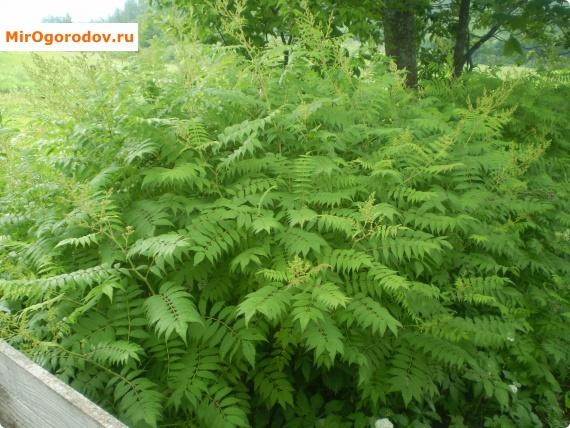

Openwork greenery
Description
The mountain ash-leaved field came to us from Asian countries. In the wild, it can be found on the banks of rivers and lakes, as well as in ravines. This plant got its name due to its high similarity with the total height of the shrub rarely exceeds three meters in height and has rather strong standing shoots about one and a half centimeters thick. The active vegetative period begins with the onset of spring and lasts almost until the first frost.
When blooming, the leaves have a pale pink color, by the middle of the season their color becomes deep green, and by the end of autumn the leaves become yellow-red. During the flowering period, the shrub is covered with white inflorescences, reaching a length of about thirty centimeters and consisting of a huge number of small snow-white flowers with long stamens. By the end of flowering, the panicles cease to have a decorative function and are removed.
Care features
Growing mountain ash in the garden is not particularly troublesome. Basic care consists of the following stages:
- Watering should be distributed so that the soil around the plant is always moist.
- It is also necessary to constantly keep the soil loose. This will allow air to flow freely to the roots.
- Grooming includes pruning. They spend it in the spring. The procedure allows you to control the height and width of the shrub. In addition, the plant takes on a well-groomed appearance.For example, if plantings of fieldfare are used as a hedge, then it is enough to leave shoots 1 m high. Flowers grow on a new growth, so pruning does not affect their quality and quantity.
Advice. Cut off sections of shoots can be used for propagation of shrubs by cuttings.
- The rowan-leaved variety does not require any warming before wintering in the open field. It is quite hardy and does not get damaged even in very cold winters.
Planting features
This shrub reproduces well both by dividing the bush and by cuttings or seeds. We will consider the process of planting mountain ash seedlings. They must be planted in early spring, without additional insulation. You should not be afraid of their freezing and death, since in the homeland of this shrub, the growing conditions are quite harsh. Therefore, the confidence in the survival of seedlings is almost 100%.
Before planting, each seedling is carefully inspected, cleaned of weak, damaged and dry shoots. Healthy and strong shoots are cut to a length of 10-15 centimeters, keeping 2-4 developing buds on each. Pits for planting are dug of shallow depth, but relatively wide (taking into account the rapidly developing root system). On average, the depth of the pit should be about 40 centimeters, and the diameter should be at least 60 centimeters. A substrate mixture consisting of one part of the earth, two parts of humus and one part of sand is poured into the pit, after which a seedling is placed and sprinkled with soil on top. After planting, the seedling is well spilled with water and mulched.
Planting and leaving
Mountain ash has a beautiful cone-shaped inflorescence
, which are formed by individual yellow flowers with a wonderful smell. The inflorescence is formed in the form of a cone. The stamens of the inflorescences are twice the length of the petal. Due to this, the inflorescences look great during the blooming period. In addition, the petals are fluffy to the touch. The flowering time of this shrub falls in the last two months of summer.
Two- or a three-year-old species will delight its owner with flowering
yearly. The fruits of the plant are not designed to be used as decor, which is why they are removed in the fall. Mountain ash is used in landscape design.
Agronomists highlight such an advantage of the plant as resistance to severe frosts. Also, fieldfare can take root well on different types of soil, but best of all - on moist soil.
It is very important to provide the mountain ash Sem with the required amount of water and moisture. Indeed, without this, the bush will grow much worse, it will remain stunted, and will lose its natural beauty. The process of plant growth can occur even when it is located in the shade. It can also grow well in a place under the crowns of trees. In the event that you provide all the necessary conditions for the plant, fieldfare grows quickly enough, and also tolerates the transplantation process well.
Experts recommend planting this plant one by one, because it grows quite widely, although such a spectacle looks quite beautiful along the river banks. If you plant a shrub in groups, then you will often need to cut it off and create a certain shape. This culture has a developed root system.
It is for this reason that the plant sits on the slopes in order to anchor the soil. These are the requirements of the mountain ash for planting and care. Consider a brief description of the requirements of the field ash Sam:

